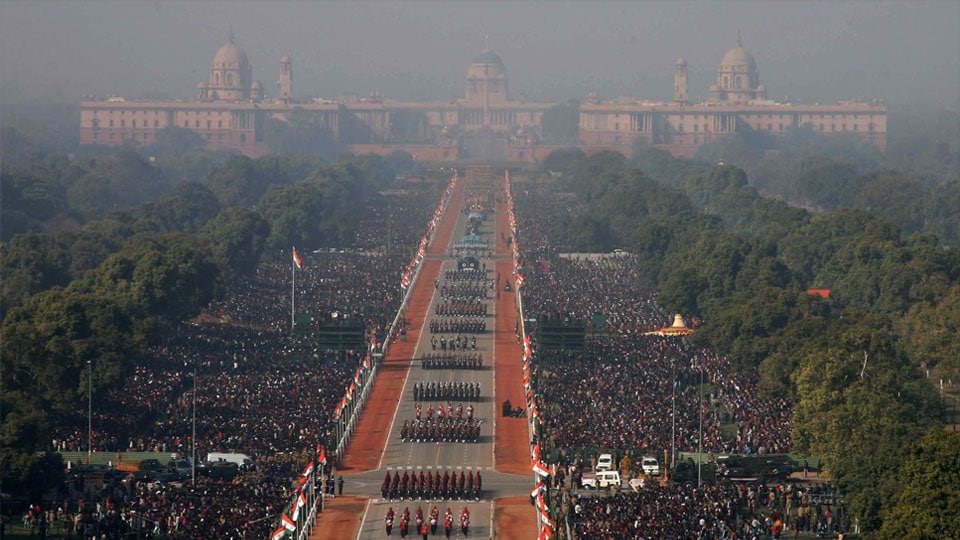By Prof. A.V. Narasimha Murthy
Indians celebrated Republic Day, popularly known as Ganarajyotsava with all solemnity and patriotism that it deserved. Years ago, I was in Delhi for some official work with Union Public Service Commission and I got a pass to witness the great spectacle of Ganarajyotsava from a vantage point and that is still green in my memory even after many years.
Republic Day has a great antiquity going back to early times in various parts of the world. In fact the celebrated Greek Philosopher Plato was perhaps the one who wrote on the connotation of Republic and very interestingly, the name of that work is ‘Republic’. According to him, in a Republic the political power of a country rests with elected representatives who are given the responsibility of running the government having welfare of people in mind. In popular parlance, it is government of the people, by the people and for the people and this is the basis of modern democracy. What a splendid and meaningful idea.
The ancient Roman Government was called a Republic for namesake by many scholars but actually it was aristocracy. It was under the guidance of people who were nobles called patricians by contemporary people. Actually, it was a government by the people who were born in higher lineage. Still they maintained that they were following Republican form of Government.
Ancient Greece was also a good example for Republican form of Government. However, in this government, the political power was confined to some groups of citizens. Italians had oligarchy form of Government which means that only limited number of people could participate in running the State.
France was basically a democracy in the modern period and it was a Republican form of Government. India was basically a democratic country after the British left us and is considered as a big democracy which, in other words, is also termed as a Republic or Ganarajya.
The main character of this form of Government is that no particular group (not a party) is empowered in this form of Government. Within the framework of the Constitution all youngsters above a particular age can elect a government through representatives which in modern parlance is Members of Parliament, the Legislative Assembly or Legislative Council. Even the communists call themselves as Republics because every citizen has an opportunity to be a part of it. This is a matter of interpretation.
When Oliver Cromwell came to power in Britain, he called it Commonwealth which means it is good for everybody or all citizens. Cromwell called it as the first Republic among the English speaking world. Its main motto was the good of all people and equal opportunity for all people immaterial of caste, creed and nationality. Poor or rich do not matter in this form of Government.
As already mentioned, historians have called the Roman Government as the first Republican form of government. It has no king or emperor but the power rests with the entire community of people. Some scholars have called Greek city states as Republics of the ancient period. The main character of this form is equality of all people and sharing power or responsibility of government by one and all in general with some conditions.
During middle between 14th and 16th centuries, many Republics came into being because of Renaissance period which brought in new thinking in social and administrative matters. The governments in Venice and Florence were in the hands of rich people. However, it was run by elected representatives. But the voice of elected representatives was not given proper importance. It was believed by the nobles and rich people that good and competent people could not be elected for various reasons. And this is happening throughout the world wherever democracy functions. No political scientist has been able to give solutions to this malady.
In the 20th century, lot of encouragement was given to Republican form of government. After the First World War, many European States came under the administration of despots or dictators. They called themselves neither despots nor republics but ruled the countries with iron hand. Even after the Second World War many countries called themselves as Republics only in name.
Republics were not confined to other countries of the world. And ancient India also had a major role to play. Many scholars have studied this problem in detail. According to them, monarchy was the popular form of Government in ancient India. The Sabhas and Samitis of the Vedic period can be equated with Republics of the modern period allowing for the modern changes.
The legends found on the seals and coins reading Malava Ganasya Jayah (Victory to Malava Gana, Yaudheya Ganasya Jayah) are especially noteworthy. From these references it becomes clear that the term Gana had a clear meaning and connotation in ancient India. At times the word Sangha also was used to denote a Gana.
Kautilya’s Arthashastra has discussed this problem in detail and in addition to monarchical form of government, he has given a high place to Ganarajya, in which peoples’ representatives are given important place. But he gives certain precautions for the election of representatives and that responsibility is given to the people who elect their representatives. He also considers it as a duty of the government to see that candidates of good character, non-corrupt and with other virtues be permitted to contest elections. Otherwise chaos will set in and enemies will take advantage.
January 26, 1950 is a red-letter day for India. On that momentous and auspicious day, at about 10.20am Babu Rajendra Prasad signed this document which made us into a Ganarajya or a Republic. Every year on 26th January, we celebrate this great event. Perhaps 15th August and 26th January every year are sacred days for Indians.
Bharata Ganasya Jayaho (Victory to Bharat Republic)








Recent Comments